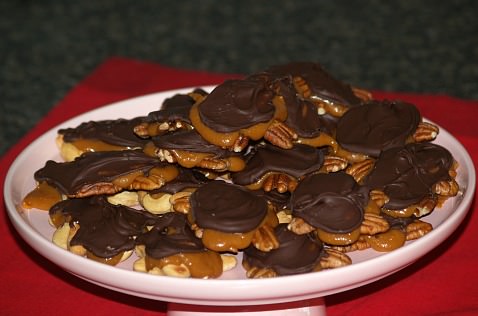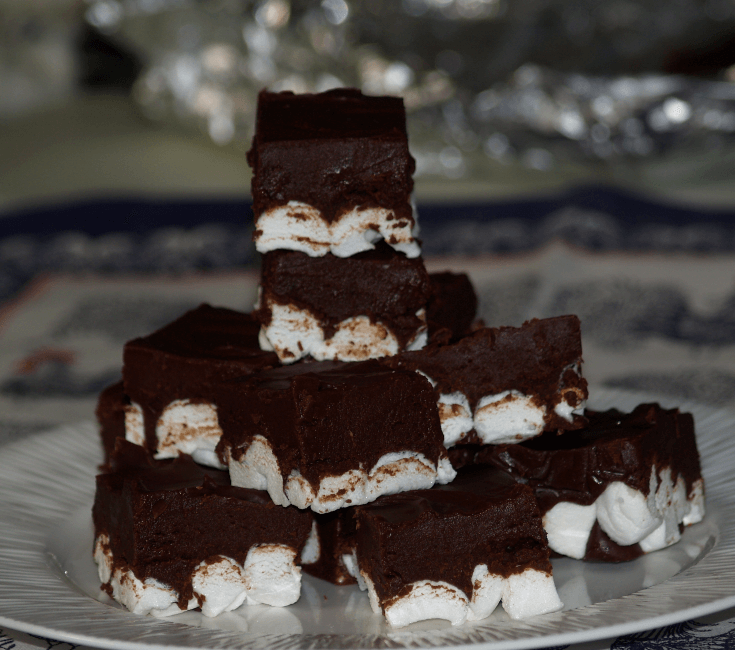- Painless Cooking
- Candy
- Candy Temperatures
Candy Temperatures Importance in Cooking Candy
When cooking candy, the candy temperatures are so important when the cooking is finished. The point at which the syrup is finished can be determined by two methods.
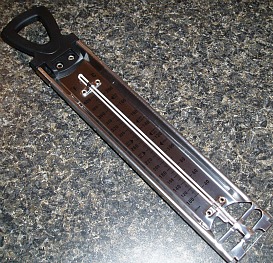
The first is the candy thermometer; this is what I highly recommend. They are inexpensive to purchase and determining the temperatures of the candy is much more accurate. With some experience the temperature can be determined by the cold water test but with less accuracy.
When using a candy thermometer to determine candy temperatures heat the thermometer up gradually. Plunging a cold one into boiling hot syrup may cause the glass to crack. When purchasing a new thermometer the rule is to check it for accuracy. (I have never bought one that was not accurate).To do a test, submerge bulb of thermometer in boiling water for several minutes before reading. At sea level the temperature should read 212F degrees at boiling. If it registers higher or lower than 212F degrees then you would add or subtract that amount of degrees to the temperatures in your recipes. For instance if your thermometer registers 214F degrees at a full boil, raise the temperature in your recipes by 2 degrees.
Testing candy temperatures with the cold water test is not hard to learn to do. With a little experience you can get by but if you are going to be doing a lot of candy making it is wise to purchase candy thermometer. I used the cold water test before I got a thermometer. I did well with the fudge recipes but I would never attempt making hard candy recipes, caramel recipes, brittle recipes or what are some of my favorites now, the taffy recipes.
To do the cold water test use a fresh cup of fresh cold water each time you test. (I use to use a small clear glass so I could see better how the syrup formed when dropped in the cold water.) Remove the pan from the heat when testing to prevent overcooking. Drop a teaspoonful of syrup into the cold water which will cool and thicken syrup. Shape the syrup into a ball and test for degree of hardness.
A very soft ball would register between 230 to 240F degrees on a candy thermometer. By the cold water test syrup will collect in one mass in the cold water but it cannot be picked up; it will fall apart.
NOTE: I have been comparing many different “supposedly reliable sources” for temperatures for how to cook candy. Each source seems to list varying temperatures to reach on a candy thermometer for different types of candy. THIS IS WHY I AM URGING YOU TO FOLLOW YOUR RECIPE CLOSELY.
NOTE: Test your candy thermometer before using to make sure of its accuracy. Without touching bottom of pan, set thermometer in boiling water for 1 to 2 minutes. It should read 212F degrees; if the temperature is BELOW 212F degrees subtract that number of degrees from the temperature called for in your recipe. If the temperature is ABOVE 212F degrees add that number to the temperature called for in your recipe.
Fudge recipes, penuche recipes and fondant recipes should register candy temperatures of soft ball stage 242 to 249F degrees on a thermometer. In a cold water test the syrup will collect in one mass when dropping in cold water; it can easily be formed into a pliable ball between the thumb and finger and picked up.
Caramel recipes should register a firm ball stage with temperatures from 242 to 248F degrees on a candy thermometer. In a cold water test the syrup mass with form into a ball without much shaping between fingers and will remain when removed from water.
A very firm ball will register between 250 to 256F degrees but can easily be pierced with a fingernail.
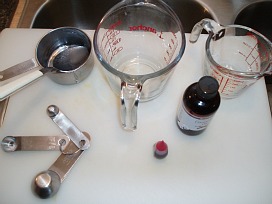
Taffy recipes and divinity recipes should register a hard ball from 260 to 270F degrees on a candy thermometer. By a cold water test the mass forms into a definite hard ball and cannot be pierced with the fingernail. At 270F degrees the ball will make a sound when dropped into the bottom of the cup.
Butterscotch recipes, brittle recipes and hard candy recipes should reach candy temperatures of the medium crack stage 275 to 300F degrees. With the cold water test at 275F degrees the syrup is brittle when under water but becomes soft and pliable when removed. As temperature rises threads snap of spoon when dropping in the water.
Lollipop recipes should be cooked to a very brittle stage registering 310F degrees on candy thermometer. When doing a cold water test, the syrup hits the water with a crackling sound. Threads will form from the tip of the spoon and break with a definite snap.
TURTLE CANDY RECIPE
Like most candy recipes the proper candy temperature must be reach for this recipe.
- 192 Pecan halves (Sometimes I substitute about 10 cashew nuts for each candy)
- 2 Cups canned condensed evaporated milk
- 2 Cups sugar
- ½ Teaspoon salt
- 1 Cup light corn syrup
- 1/3 Cup butter
- 1 Teaspoon vanilla
- 1 Package (12 ounces) semi sweet chocolate chips
Butter baking sheets; arrange pecan halves in groups of 4.
In a large heavy saucepan heat cream until lukewarm; take out 1 cup and reserve.
Add sugar, salt and corn syrup to pan with remaining milk.
Over MEDIUM heat bring to a boil CONSTANTLY stirring lightly.
Very slowly stir in reserved cream so that mixture does not stop boiling.
Cook and STIR MIXTURE for 5 minutes; stir in butter ONE TEASPOON at a time.
Turn heat to HEAT TO LOW; lightly STIR and boil gently until candy thermometer registers 248f degrees.
REMOVE FROM HEAT; gently stir in vanilla.
Cool SLIGHTLY; spoon about 1 teaspoon caramel mixture over nuts covering to resemble turtles.
Cool 10 minutes; melt chocolate chips over hot water and spread over caramel.
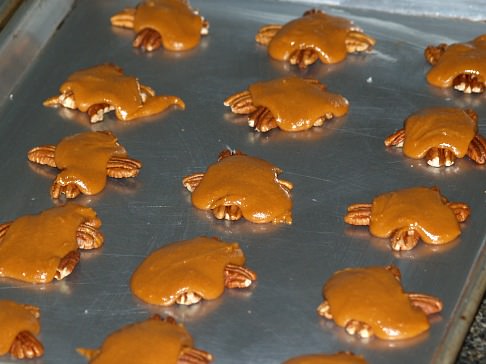 Cream Mixture Spooned over Pecan Nuts
Cream Mixture Spooned over Pecan Nuts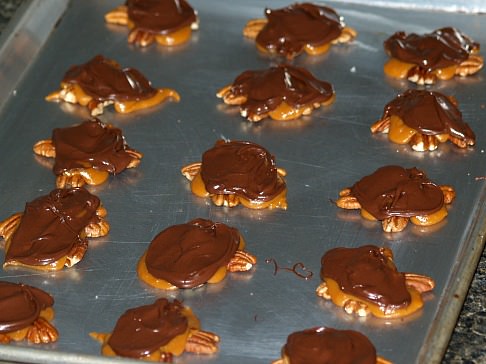 Melted Chocolate Spooned Over Pecans and Cream Mixture
Melted Chocolate Spooned Over Pecans and Cream Mixture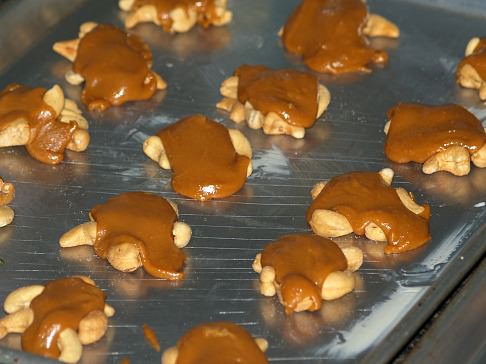 Cream Mixture Spooned over Cashew Nuts
Cream Mixture Spooned over Cashew Nuts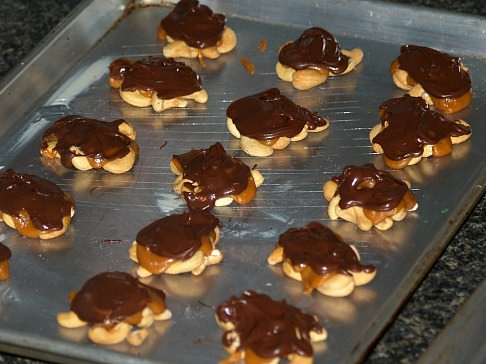 Melted Chocolate Spooned Over Cashews and Cream Mixture
Melted Chocolate Spooned Over Cashews and Cream MixtureBelow are two fudge recipes; the candy temperatures are determined by the two different methods.
CHOCOLATE FUDGE
- 2 Cups white sugar
- 1 Cup brown sugar
- 1 Tablespoon cocoa powder
- ¼ Teaspoon salt
- 1 Cup cream
- ½ Cup milk
- ½ Teaspoon vanilla
- ½ Cup crunchy peanut butter
Mix white and brown sugar in a heavy saucepan; add cocoa, salt, cream and milk and blend.
Place on low heat and stir until sugar is dissolved before bringing to a boil.
Raise heat and bring to a boil (do not stir); cook until mixture forms soft ball when dropping in cold water.
Remove from heat, cool 5 minutes, add vanilla and beat until it starts to cool.
Add peanut butter and continue beating until mixture holds its shape.
Pour onto buttered plate and let set to cool.
MARSHMALLOW FUDGE
- 3 Cups sugar
- ½ Cup cocoa powder
- 1 ¼ Cups milk
- 3 Tablespoons light corn syrup
- 1 Tablespoon butter
- 1/8 Teaspoon salt
- 1 ½ Teaspoon vanilla
- 20 Regular marshmallows
Butter 9 inch pan; cut marshmallows in quarters and arrange layer in bottom of pan.
Mix together in saucepan sugar, cocoa powder, milk and corn syrup; blend well.
Cook over low heat stirring constantly until sugar dissolves.
Boil slowly to 234F degrees (soft ball stage); stir occasionally.
Cool at room temperature until lukewarm without stirring.
Add butter, salt and vanilla; beat candy until mixture holds shape.
Pour chocolate mixture over marshmallows in pan.
Cool to room temperature; cut into squares.
